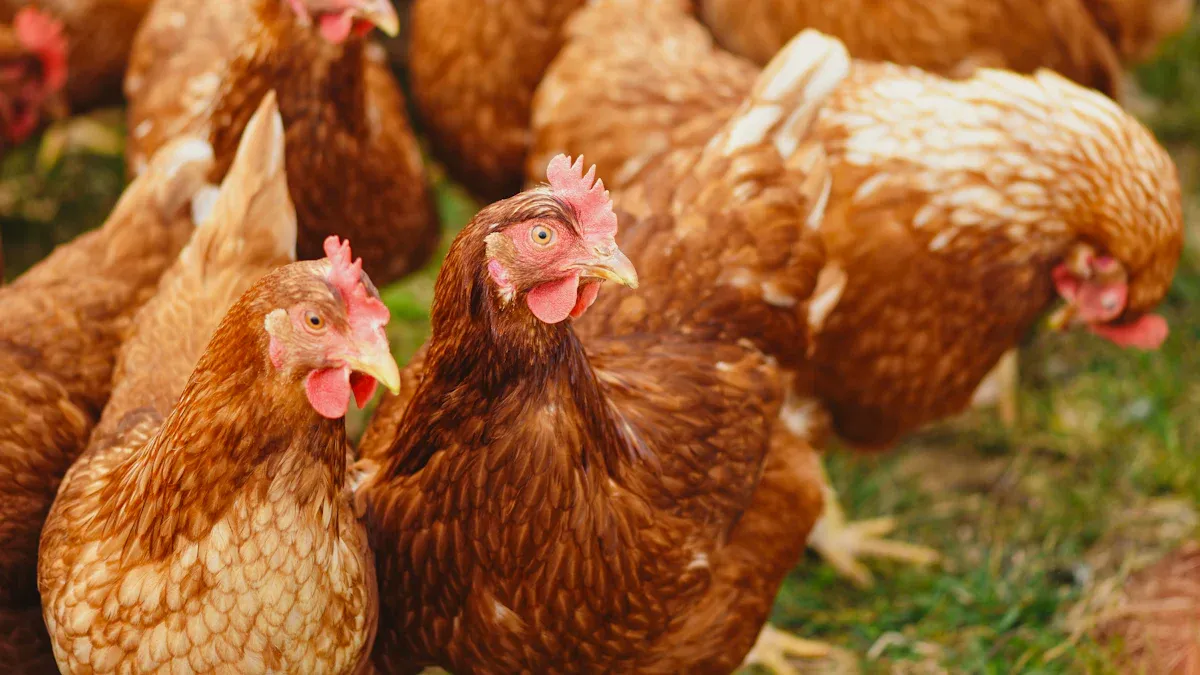
Mealworms in the feed provide poultry with rich protein levels, ranging from 45.83% to 54.4% dry matter. Studies show improved growth and better health indicators in poultry that consume mealworms.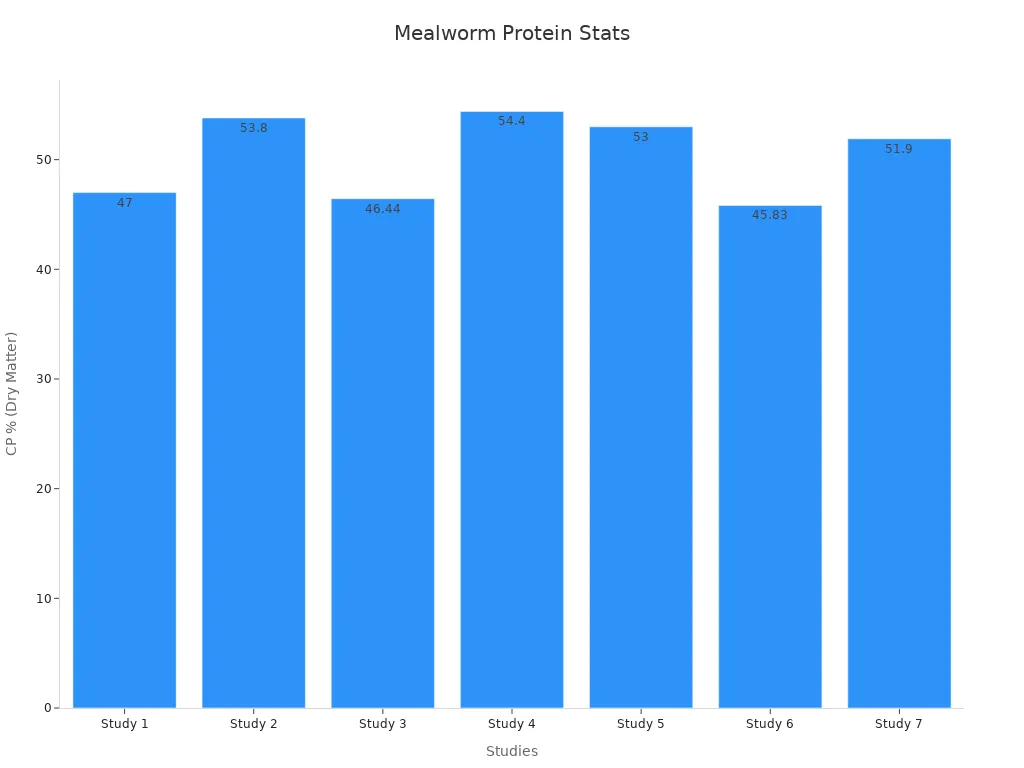
These benefits make mealworms a valuable addition to modern poultry diets.
Key Takeaways
- Mealworms provide poultry with high-quality protein and essential nutrients that support growth, feather development, and egg production.
- Adding mealworms to poultry feed improves bird health, boosts immune function, and enhances meat and egg quality.
- Using mealworms in feed offers a sustainable, cost-effective solution that reduces environmental impact and supports modern poultry farming.
Nutritional Benefits of Mealworms in the Feed
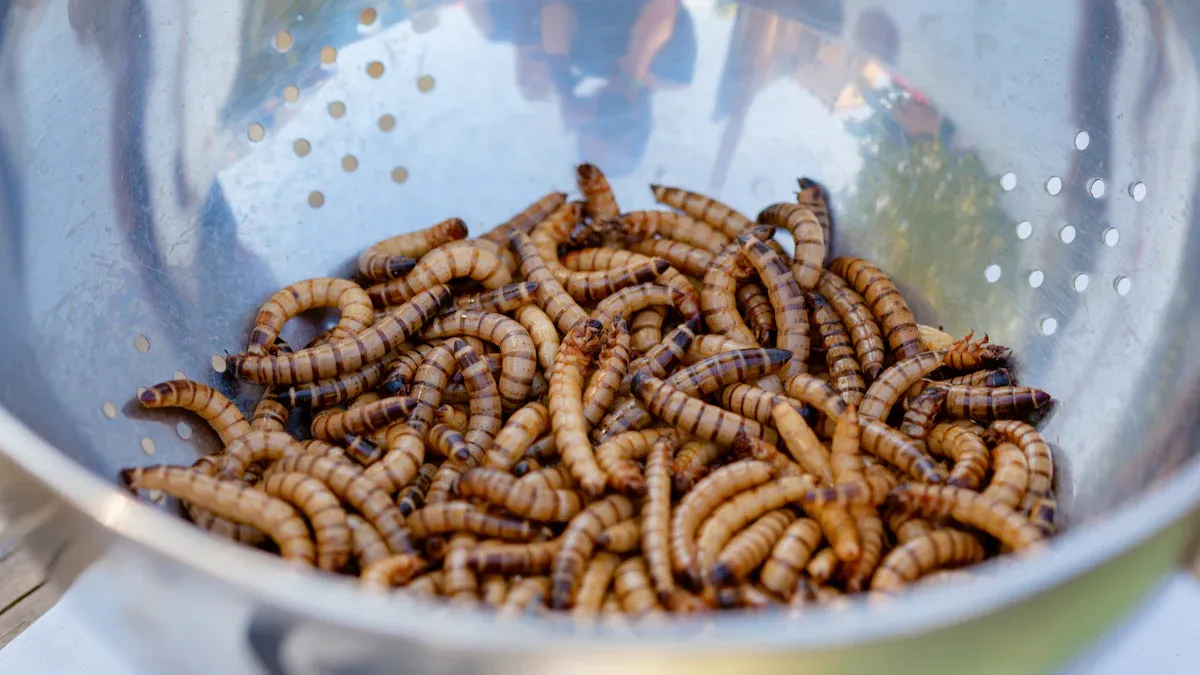
High Protein Content
Mealworms provide a rich source of protein for poultry. Research shows that mealworms (Tenebrio molitor larvae) contain about 53% protein on a dry basis. This level matches or exceeds many traditional protein sources. The protein in mealworms meets the essential amino acid requirements set by the World Health Organization. Regulatory agencies in the European Union and Korea have recognized mealworms as a safe and nutritious food source. Studies highlight the favorable amino acid profile of mealworm proteins and their successful use as substitutes for conventional protein sources in food products. Selaledi et al. (2020) reviewed the nutritional composition and digestibility of yellow mealworms, confirming their value as an alternative protein source in poultry diets. Mealworms in the feed help support growth and development in birds, making them a smart choice for modern poultry producers.
Tip: Dried mealworms can be easily mixed with regular poultry feed, providing a convenient way to boost protein intake.
Essential Amino Acids
Poultry need essential amino acids for muscle growth, feather development, and egg production. Mealworms offer a balanced amino acid profile that supports these needs. Scientists compared the amino acid profiles of mealworms and soybean meal using statistical analysis. The results showed that mealworms provide similar or better levels of essential amino acids compared to soybean meal. This makes mealworms a valuable addition to poultry diets, especially when aiming for optimal bird health and productivity.
Healthy Fats and Fatty Acids
Mealworms supply healthy fats and fatty acids that benefit poultry nutrition. The larvae and pupae stages of mealworms contain higher crude fat and total fatty acids than adult mealworms. These fats are important for energy and help improve the digestibility of the feed. The table below shows how the fat content in mealworms can vary depending on what they eat:
| Mealworm Stage | Crude Fat Content | Total Fatty Acids | Digestibility Compared to Soybean Meal |
|---|---|---|---|
| Larvae | High | High | Similar |
| Pupae | High | High | Similar |
| Adults | Lower | Lower | About 30% lower |
Mealworms in the feed provide a valuable source of healthy fats, supporting energy needs and overall health in poultry.
Vitamins and Minerals
Mealworms also contribute important vitamins and minerals to poultry diets. The mineral content in mealworms can change based on what they eat. For example, mealworms fed with fermented chicory roots or horticultural foliage show increased calcium and magnesium levels. The table below summarizes mineral content trends:
| Mineral | Effect of Feed on Larvae Content |
|---|---|
| Calcium (Ca) | Increases with certain feeds like fermented chicory roots |
| Magnesium (Mg) | Low when feed Mg is low; can increase with specific feeds |
| Sodium (Na) | Lowest with horticultural foliage feed |
| Potassium (K) | Larvae K content does not always reflect feed K levels |
| Phosphorus (P) | Larvae P content does not always reflect feed P levels |
Although exact vitamin values are not always available, mealworms still provide a range of essential nutrients. These nutrients help support bone strength, nerve function, and overall well-being in poultry.
Note: When adding mealworms to poultry diets, producers should ensure a balanced mix with other feeds to meet all nutritional needs.
Impact of Mealworms in the Feed on Poultry Health and Performance
Enhanced Growth and Feed Efficiency
Poultry producers look for ways to help birds grow faster and use feed more efficiently. Mealworms in the feed can make a big difference. Studies show that adding mealworm meal to broiler diets increases both live weight and carcass weight. The following table shows how different levels of mealworm meal affect growth in broiler chickens:
| Parameter | 0% MWM (Control) | 2% MWM | 4% MWM | 6% MWM | 8% MWM | 10% MWM |
|---|---|---|---|---|---|---|
| Live weight (g) | 2873.4 | 2975.9 | 3027.1 | 3095.0 | 3179.0 | 3214.4 |
| Carcass weight (g) | 2020.8 | 2163.3 | 2211.7 | 2287.5 | 2374.2 | 2400.8 |
| Dressing % (CW/LW) | 70.34% | 72.71% | 73.02% | 73.92% | 74.69% | 75.77% |
| Feed conversion ratio | 1.82 | 1.70 | 1.70 | 1.64 | 1.58 | 1.55 |
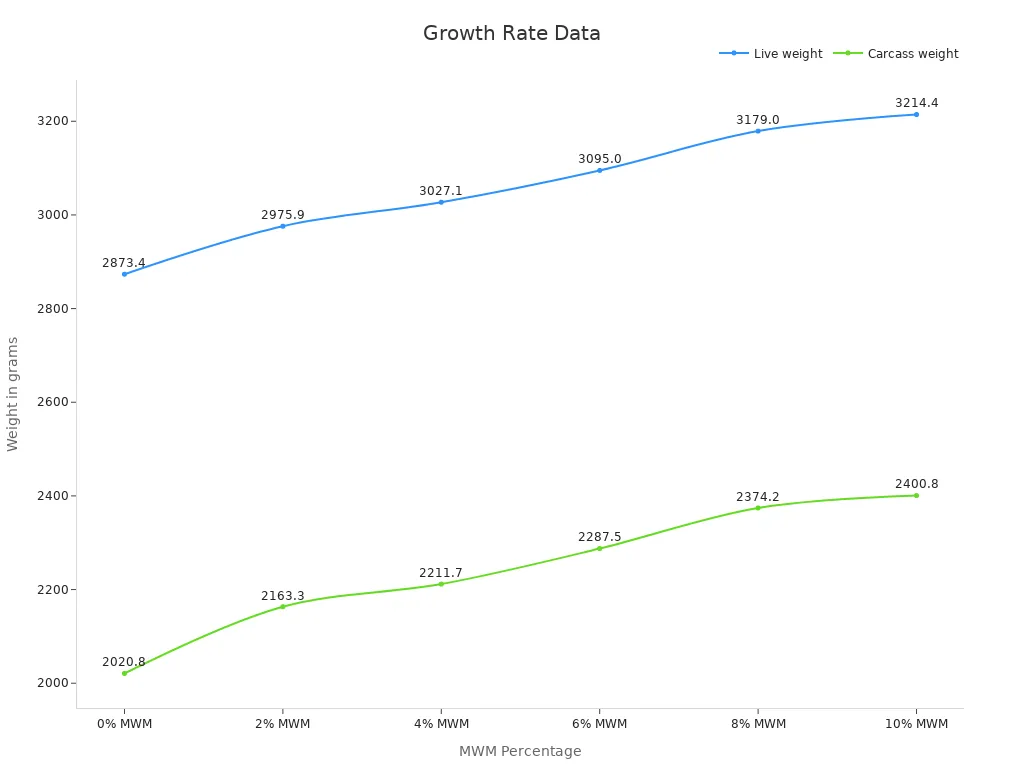
The chart above shows a steady increase in live and carcass weights as the percentage of mealworm meal rises. Birds fed with 6% mealworm meal reached the best growth performance. The feed conversion ratio also improved, which means birds needed less feed to gain weight.
Researchers found that mealworm inclusion helps birds grow faster and use feed more efficiently. For example, broiler chickens fed diets with 5%, 10%, and 15% mealworm meal showed higher body weight and better feed conversion. Even small amounts, like 0.2% to 0.3%, improved weight gain and feed efficiency in different poultry breeds. Japanese quails and barbary partridges also showed better growth and feed use when mealworms replaced part of their regular protein sources.
Tip: Adding dried mealworms to poultry feed can help producers achieve better growth rates and save on feed costs.
Immune System Support
A strong immune system helps poultry stay healthy and resist disease. Researchers have found that mealworm supplementation can boost the immune response in birds. Some key findings include:
- Supplementing broiler diets with 2.0% full-fat mealworm larvae meal increased innate immune responses.
- Birds fed 2.0% mealworm meal showed higher hemolytic activity of the alternative complement system compared to control groups.
- Myeloperoxidase activity, another marker of immune strength, was also higher in birds receiving mealworm meal.
- These immune benefits appeared even in birds not exposed to immune challenges, showing a baseline improvement.
- Growth performance improved alongside immune function, making mealworm meal a functional ingredient for poultry health.
Mealworms in the feed provide not only nutrition but also help birds build a stronger defense against illness.
Support During Molting
Molting is a natural process where birds shed old feathers and grow new ones. This period can be stressful and requires extra nutrients, especially protein. Mealworms offer a rich source of protein and essential amino acids like leucine, which supports feather regrowth and calcium uptake. Birds that receive mealworms during molting often show faster recovery and better feather quality.
Poultry keepers can scatter dried mealworms in the coop or mix them with regular feed during molting. This practice gives birds the extra nutrition they need to stay healthy and productive. Many producers notice that hens return to laying eggs sooner and maintain better body condition when mealworms are part of their diet during this time.
Note: Always provide mealworms as part of a balanced diet, especially during molting, to ensure birds receive all necessary nutrients.
Effects of Mealworms in the Feed on Meat and Egg Quality
Improved Meat Quality
Mealworms in poultry feed can improve the quality of chicken meat. Birds that eat mealworms often show better muscle development. Their meat contains higher protein and healthier fat levels. Studies report that chickens fed mealworm meal have firmer texture and juicier meat. The fat from mealworms adds more unsaturated fatty acids, which are good for health.
Producers notice that mealworm-fed chickens have brighter skin and better flavor. The table below shows some common changes in meat quality:
| Quality Trait | Mealworm-Fed Chickens | Regular Feed Chickens |
|---|---|---|
| Protein Content | Higher | Standard |
| Fat Quality | More unsaturated | Less unsaturated |
| Meat Texture | Firmer, juicier | Standard |
| Skin Color | Brighter | Duller |
Tip: Dried mealworms can be mixed into feed to help boost meat quality in broilers.
Enhanced Egg Production and Quality
Mealworms also support better egg production and quality. Hens that eat mealworms lay more eggs and larger eggs. The eggs often have stronger shells and brighter yolks. Mealworms provide protein, vitamins, and minerals that help hens stay healthy and productive.
Some benefits of mealworms for egg-laying hens include:
- Increased egg count per week
- Improved eggshell strength
- Richer yolk color
- Higher nutrient content in eggs
Many poultry keepers use dried mealworms as a supplement to regular feed. This practice helps hens produce high-quality eggs that appeal to consumers.
Note: Mealworms should be part of a balanced diet for the best results in both meat and egg quality.
Economic and Environmental Advantages of Mealworms in the Feed
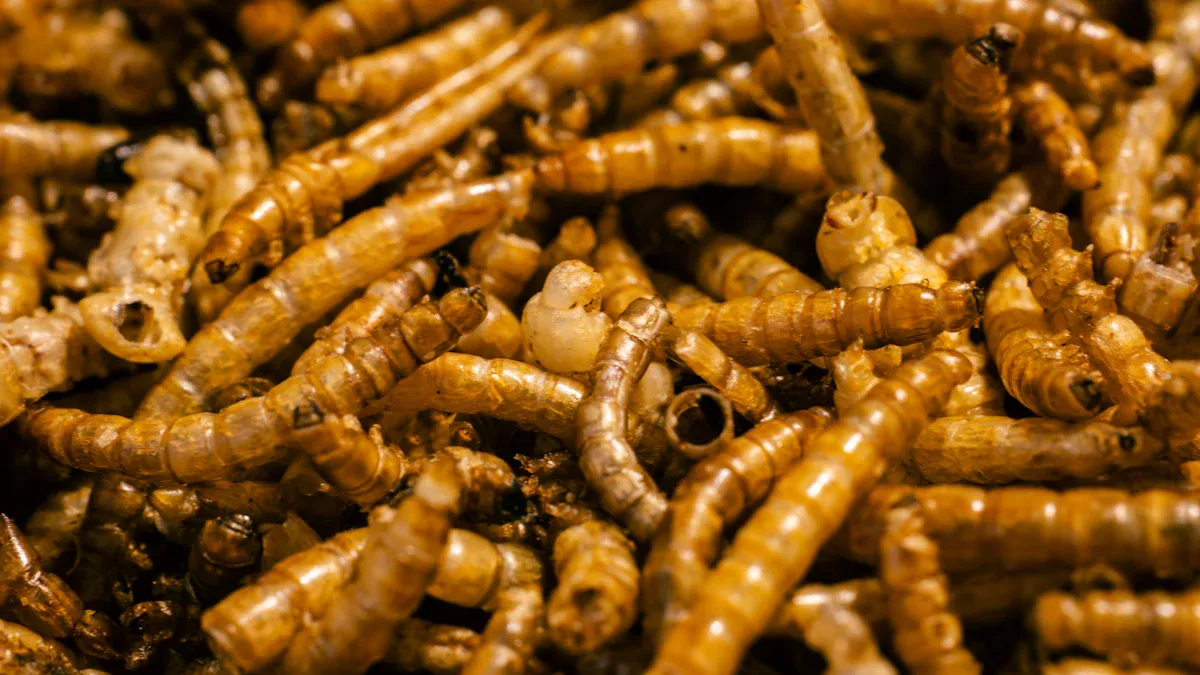
Sustainability and Resource Efficiency
Mealworms in the feed offer a sustainable solution for modern poultry farming. Researchers have found that mealworm production uses much less water than traditional livestock farming. For example, Miglietta and colleagues (2015) showed that mealworm farming requires only a small fraction of the water needed for raising cattle or chickens. Other studies, such as those by Oonincx and de Boer (2012), show that mealworm production leads to lower greenhouse gas emissions, less land use, and reduced energy consumption. These numbers highlight the environmental benefits of using mealworms as a protein source. Farmers who choose mealworms help reduce the strain on natural resources and support a more sustainable food system.
🌱 Mealworms can be raised on organic waste, turning leftovers into valuable protein for poultry.
Cost-Effectiveness for Poultry Producers
Economic research compares the costs of yellow mealworm feed with traditional feeds like fishmeal and soymeal. Case studies from Norway and Lithuania show that, while current costs may be higher, scaling up production and improving technology can make mealworm feed more affordable. These studies use real data from pilot factories and start-ups. They show that mealworm meal can replace imported feed ingredients, which helps reduce costs in the long run. The circular economy benefits also add value, as mealworm farming can use local waste streams and create new business opportunities. Poultry producers who invest in mealworm feed today may see greater savings and profits as the industry grows.
| Feed Type | Water Use | Land Use | Greenhouse Gas Emissions | Cost Trend (with scale) |
|---|---|---|---|---|
| Mealworm Meal | Low | Low | Low | Decreasing |
| Fishmeal/Soy | High | High | High | Stable/Increasing |
Safety and Practical Considerations for Using Mealworms in the Feed
Safety and Contaminant Risks
Producers must ensure that mealworms in the feed are safe for poultry. Clean production practices help prevent contamination. Farmers should source mealworms from trusted suppliers. Safe mealworms do not contain harmful bacteria or pesticides. Regular testing can check for heavy metals and pathogens. Poultry that eat safe mealworms show healthy growth and strong immune systems.
Tip: Always store dried mealworms in a cool, dry place to prevent mold and spoilage.
Processing and Handling Methods
Mealworms can be fed live or dried. Dried mealworms are easy to store and mix with regular feed. Proper drying removes moisture and helps prevent spoilage. Some producers roast or freeze-dry mealworms for longer shelf life. Clean handling tools and containers keep the feed safe. Farmers should wash hands after handling live mealworms.
| Method | Benefit |
|---|---|
| Dried | Easy storage, safe |
| Live | Natural enrichment |
| Freeze-dried | Long shelf life |
Recommended Inclusion Rates and Feeding Practices
Experts recommend adding mealworms in the feed as a supplement, not as the main protein source. Most poultry benefit from 2% to 6% mealworm meal in their diet. Farmers can scatter dried mealworms in the coop or mix them with other feeds. Overfeeding can cause health problems, so moderation is important. Producers should also provide calcium supplements when using mealworms.
- Start with small amounts.
- Watch for changes in bird health.
- Adjust the amount as needed.
Mealworms in the feed offer poultry a balanced and sustainable protein source. Studies show improved nutritional value and no negative impact on growth.
- Survival rates remain stable with different diets.
- Protein and fat levels increase, supporting productivity.
Their use supports bird health and future environmental goals.
FAQ
What is the best way to feed mealworms to chickens?
Chickens can eat dried or live mealworms. Farmers often mix dried mealworms into regular feed or scatter them in the coop for enrichment.
Tip: Always store dried mealworms in a cool, dry place.
How often should poultry eat mealworms?
Poultry should eat mealworms as a treat, not as the main food. Most experts suggest offering mealworms two or three times per week.
Can mealworms improve egg production in hens?
Yes. Mealworms provide protein and nutrients that help hens lay more eggs with stronger shells and brighter yolks. Many poultry keepers see better results with regular mealworm supplements.


